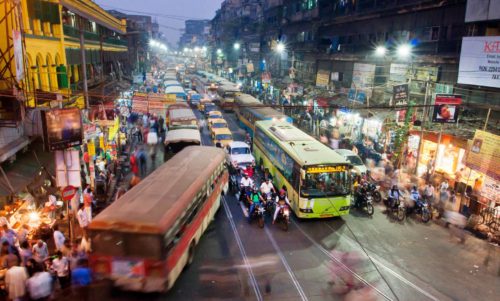KOLKATA, INDIA - JAN 22: Dark city traffic blurred in motion at late evening on crowded streets on January 22, 2013 in Calcutta. Kolkata has a density of 814.80 vehicles per km road length

Preparing India for 5,500 Electric Buses
COVID-19 measures have strained India’s public transport operators, causing financial losses and impacting ridership and service levels. Ensuring safe public transport and restoring demand are top short-term priorities for the sector. As the country’s cities and state transport undertakings (STUs) rebound, it is essential that they continue to work toward electrifying their bus fleets under the Department of Heavy Industry’s FAME II program.
Why? Electric buses offer many value propositions to cities: they are more efficient, more reliable, cleaner, quieter, and increasingly cost competitive. As per an RMI analysis, By 2030, four in ten buses sold in India could be electric.
Moreover, the central government has allocated 35.45 billion Indian rupees (Rs) (US$486 million) in incentives to support the adoption of 7,090 e-buses-amounting to a subsidy of Rs 5 million (US$69,000) per bus. To date, 5,595 e-buses have been sanctioned to 64 cities and STUs. As per an RMI analysis, over their lifetimes, they will run 3 billion kilometers without tailpipe emissions, produce oil import savings of 5.5 million barrels of oil equivalent worth Rs 36 billion (US$493 million), and avoid 1.2 million tons of carbon dioxide emissions.
Yet to realize those benefits, city authorities and the ecosystem must proactively prepare to address several key challenges related to e-bus tendering and operations.
One, integrated planning by STUs and urban local bodies will be required to prepare for e-bus tendering and operations. For e-buses, depot and route selection are critical precursors to cost-effective and efficient operations. Proper depot selection has the potential to reduce investment cost in grid upgrades and support higher utilization of charging infrastructure. Proper route selection has the potential to reduce the replacement ratio (i.e., the need for spare buses), ensure scheduling adherence, and increase profitability. Incorporating appropriate depot and route details in Request for Proposal documents can support better bidding and operational planning.
Two, Indian cities aspiring to transition their fleets will need to ensure that proper electricity infrastructure is in place. Charging an e-bus requires a high-voltage electricity connection, transfer equipment, and ancillary infrastructure.
Authorities can work with local distribution companies to identify suitable locations and evaluate what network upgrades will be necessary. They can also work with charging companies to issue separate tenders for electric vehicle supply equipment (EVSE) to avoid unnecessarily high costs, as the lifetime of the EVSE is much longer than that of the buses. With smart charging, these companies can not only provide charging as a service, but also monetize grid benefits such as demand response. They could even provide an end-to-end clean energy solution with integrated renewables.
Three, contracting and financing terms can better reflect the needs of cities and operators. To avail the Rs 5 million subsidy, cities are required to procure e-buses on a gross cost contract, in which the authority pays an operator a per-kilometer fee for bus services on specific routes; the authority handles scheduling, route planning, and fare collection, and the operator handles operations and maintenance. Under this contract structure, cities want shorter contract periods, lower minimum payment amounts for escrow accounts, and longer repayment timelines.
OEMs and operators are looking for greater consistency in contracts across cities and better financing through viability gap funding from state governments, higher loan-to-value ratios, the ability to reduce bank guarantees annually, and potentially project finance in the future. Ironing out the details of these terms will be critical to effective contract execution for e-buses.
Four, considering the early stage of domestic e-bus manufacturing, OEMs and cities should try to simplify product specifications in the short term. Discussions with experts suggest that with only nine e-bus products available in the market, product availability and customization are currently limited. Prioritizing e-bus models that meet most local needs and driving conditions can help the current generation of e-buses hit the road as soon as possible. In the long term, as sales volumes increase, OEMs can grow product lines and accommodate more optionality.
Initial e-bus orders have the potential to provide a major boost to local manufacturing of battery cells and packs, electric motors, and other components. As per an RMI analysis, assuming a battery size of 250 kilowatt-hours per bus, the 5,595 e-buses will initially require 1.4 gigawatt-hours of lithium-ion batteries—over 10 percent of India’s vehicle-related domestic battery demand through 2022.
Further actions can be taken to ease and speed India’s transition to e-buses. Cities can set municipal bus replacement targets, like some Chinese cities, to provide long-term demand signals to industry. OEMs can explore R&D in areas such as lightweighting and low-rolling-resistance tires, like American e-bus manufacturer Proterra, to reduce battery size and improve range. Financial institutions can design bulk procurement programs and create bus leasing companies, similar to the aircraft leasing business, to leverage economies of scale and reduce unit costs. In addition, the public and private sectors can begin to assess how to electrify the more than 1 million buses that are privately operated in India.
While India’s journey to bus electrification faces challenges, it can get off to a strong start if the country’s ecosystem ensures the successful tendering and operation of these initial 5,595 e-buses. Government leaders, OEMs and operators, and industry experts can help by working together to address existing barriers across planning, contracting, financing, operations, and manufacturing.
If they succeed, India’s path to bus electrification could support the country’s green economic recovery and become a model for other developing nations.
This blog was initially published on the Clean Mobility Shift website.